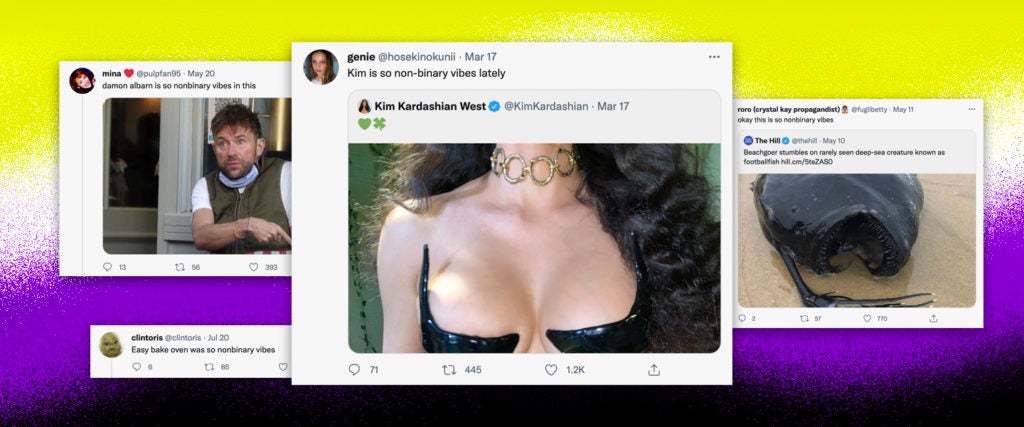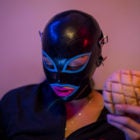We live in an economy of vibes. Good vibes, bad vibes, weird vibes, Boss Baby vibes — it feels like as the pandemic wears on, the word “vibes” has grown ever more prominent in our lexicon as a descriptor for the ephemeral. Perhaps it’s because we’ve spent so much time detached from normal life this past year. We’ve lost a sense of the concrete aspects of day-to-day living — even if the vibes are off, they’re all that remain.
Of particular note are “non-binary vibes,” a phrase I keep seeing on Twitter to describe everything from babies to easy bake ovens to celebrities that don’t identify as non-binary at all. But what are non-binary vibes? Where do they come from? And why does Gorillaz/Blur frontman Damon Albarn have them?
babies are soooo nonbinary vibes.. it doesn’t get more gender neutral than that
— ✧ (@northstardoll) June 5, 2021
[playing Hasbro’s 1982 hit game “Guess Who?”] is ur character nonbinary vibes?
— fleur (@gaybugfeet) May 20, 2021
As it stands, “non-binary vibes” seem to be an offshoot of the wider trend of referring to things that are unrelated to a LGBT identity as being part of that identity. Other examples include calling two people or objects next to each other “T4T” (a shorthand term for two trans people in a romantic relationship) or insisting that cuffing your pants is a trait inherent to bisexuals. Them writer P.E Moskowitz covered this seemingly innocuous trend of queer generalizations in a satirical essay entitled “I’m So Trans When I Turn On My Lamp.” In it, she writes that we’ve “reached a fever pitch of describing everything as queer, trans and all the rest because we have so little that is actually queer in our lives.”
Non-binary vibes have been particularly prominent over the last year on Reddit, but the term’s memetic ascension seems to have begun following the launch of Vogue’s December 2020 issue. That was the month that Harry Styles, an ostensibly cis man, appeared on the cover in a billowing, effeminate white dress, playfully attempting to blow up a baby blue balloon.
In response, Twitter user @PrEPReading posted a since-deleted tweet commending Styles’ and applauding him for his so-called “non-binary vibes.” The post went viral and the account, which currently has less than 100 followers, was quickly inundated with people criticizing them for describing a gender identity as a “vibe” and ascribing it to someone who has only ever claimed to be cis.
But the peak of the vibe-storm was still to come. In early 2021, Twitter user @hosekinokunii (who goes by Genie) posted two tweets, each of which stated that a member of the Kardashian family (Kim and Kylie, respectively) have, you guessed it, non-binary vibes. Genie — who identifies as a non-binary trans woman — wrote that, after seeing the original tweet about Styles, she found the term to be a funny way of describing things. Unfortunately, the hordes of Queer Twitter didn’t agree. For the most part, they took it at face value and roasted the tweets relentlessly. Many claimed that joke or not, it was disrespectful and harmful to categorize a gender identity as a vibe or style.
why would you tweet this ???? pic.twitter.com/O1c8DIIdlm
— ✧・゚: *✧・゚angel (they/them)・゚✧*:・゚✧ (@fleshofangels) March 18, 2021
they’re seriously giving such nonbinary vibes pic.twitter.com/hR45oLqo6u
— roro (crystal kay propagandist)?? (@fuglibetty) May 23, 2021
Since then, people have been posting about non-binary vibes on Twitter around the clock, and their tweets can be pretty unhinged. Most of the time, people ascribe these vibes to intentionally grotesque things such as Jar Jar Binx, a dead football fish or Prince Philip, but they also slap them on images of traditionally feminine white women like Florence Welch, Ariana Grande or Lydia Deetz from Beetlejuice. Whether joking or not, the generalizations each poster makes speaks to how they each conceptualize being non-binary. Also of note is that these statements are almost never assigned to queer or non-binary people, or characters in queer media.
and so then the jokes goes from being “my relationship w/gender is so complex that i can make these weird hyperspecific abstractions” to “this is Relatable to the Nonbinary Community as a Whole”
— mr. rager’s neighborhood (@lilgrapefruits) August 12, 2021
Some say the trend is just harmless, absurdist humor, stating that “it’s just a way to say ‘visibly trans’ in a kind of wacky way.” Others feel it misconstrues what being non-binary really is (it’s an identity that exists outside of the gender binary, thanks for asking). As @gentlevoid says on Twitter, “By presenting the idea that nonbinary gender is something that can have a unified aesthetic, it endorses the incorrect perception of nonbinary gender as a ‘third gender.’”
Personally, I think it’s a tired joke that, while generally inoffensive, further pulls meaning from a word whose definition is already murky. It doesn’t describe a set of lived experiences particularly well, and it’s better used as a label of gender itself. While there can be no monolithic culture for any identity, words have meaning, and if anything can be non-binary, then nothing really is.
I don’t know if the vibes are off on this one, but they’re definitely not on.

